This post will look at why I started again to try to organise my postage stamps. After 50 years I will need to find new information resources, learn a new vocabulary, and understand how to judge the quality of each of my postage stamps. Then I will need to apply everything I’ve learned to arranging my ‘shoeboxes’ of old stamps.
Introduction
As a kid I had a collection of postage stamps. I don’t remember buying any stamps, so most of them must have come from my Dad, who for a time worked in the Post Office. But I also remember I enjoyed collecting them. I bought a special album for them, stencilled a country and/or year on each page, and carefully displayed my stamps each with its stamp hinge (I read recently that hinges are a bad thing).
I’m certainly not a philatelist, nor even a stamp collector, but I remember keeping all my stamps in a shoebox, and I did enjoy sifting through them and displaying the best ones in my stamp album.
I probably stopped “accumulating” stamps when I was around 15-16, and I certainly never thought about stamps after the age of 18, when I went off to study physics.
But once a stamp accumulator, always a stamp accumulator, and well into my 50’s I would cut off nice looking stamps and dump them in a shoebox hidden away on a top shelf in the study. Plus my Dad would occasionally give me an old envelope or a small box full of stamps, which went on the same top shelf, without being looked at.
Fast forward more than 50 years, and with the passing away of my parents, I found myself with a few pages from my old stamp collection, plus another box load of old stamps to add to my shoeboxes on that top shelf. So what looked like 1000’s of stamps, many still stuck to bits of old envelopes. At one point my shoeboxes of old stamps overflowed, and were relegated to the garage, later to be forgotten in some dusty corner. Occasionally a new shoebox would appear as if by magic.
It was in 2023 that we finally decided on a “clean up or throw out”. I thought to throw them out, but it was the Italian stamps that somehow stopped me from just dumping them all in the nearest bin. My wife and I had lived in Italy for some years, and I found that my Dad had somehow collected a lot of Italian stamps over the years. How could I just leave them all sitting in old shoeboxes, and simply throw them out without even looking at them?
So my shoeboxes of old stamps was promoted to the “clean up” list.
My plan was to go through them (soak off the stamps from the old bits of envelopes, etc.) and arrange them. Not collecting, just organising and arranging what was in the shoeboxes. My idea was that once I could isolate the decent looking stamps, they would just fit in one or two albums (I would bin the rest). As they say “done and dusted”.
It’s amazing, as I hunted around the house I started to find here and there little envelopes full of more old stamps (plus the old shoeboxes in the garage). It was as if the envelopes were hiding, to avoid being thrown in the bin. On top of that, when I mentioned that I would be “arranging” my old stamp collection, a few of my older friends said I could have their old albums and shoeboxes (their kids didn’t want them). In fact they sounded relieved to get rid of them. Couldn’t say no, so I suddenly inherited about 15 kg of albums, home to an assortment of old stamps. In total five different ring binders and four stock books, plus lots of loose pages, some pages were covered with stamps whilst others almost totally empty.
When I started I still had the illusion that once nicely arranged, I would have a few albums that would no doubt find a place back on a top shelf somewhere. And probably be forgotten.
After a rapid look through my shoeboxes of stamps I could see that I had more or less stops “collecting” in late 60s, but over the years I had ‘accumulated’ a lot of European and US stamps. My Dad appeared to have collected a lot of Italian stamps, and also a lot of stamps from past British colonies (many of which have since changed their names). Immediately I saw that there were some places that I didn’t even know issued stamps, eg. Isle of Man, Gibraltar, Monaco, etc.
But in addition I had also inherited a sizeable horde of French stamps. My wife is French, and so we also had a big box of French stamps accumulated by her parents over the last 60-odd years, many still stuck to old envelopes and postcards. Once I had started on my UK and Italian stamps, how could I not also open that box of French stamps.
What was in my 'shoebox' of postage stamps?
Well firstly, I now had several large boxes, containing stock books, albums, collections of old envelopes and postcards, loose pages, etc.. and envelopes with lots of stamps inside, almost totally unorganised. Some might have been once organised, some even nicely presented, a very small number labelled, but almost all pre-2000, and many pre-1980s. There appeared to be no rhyme nor reason. Why was there an unopened collection of Vietnamese stamps? Why was there a lots of stamps from the Isle of Man? Why old Hong Kong stamps? Why lots of Australian stamps, as well as stamps from small Pacific nations? Who collected stamps from the Vatican for a few years, but then apparently gave up?
And to make things worse, without realising just how many stamps would arrive from our friends, I thought it would be a good idea to buy some stamps “to fill gaps”. Mistakenly I bought some bulk lots that mentioned Italy and/or France, based solely on the lowest price possible. I even bought a few kg’s of world stamps for less than $100, just in case! More fool me!
So my imaginary shoebox rapidly grew to weigh about 25 to 30 kg of stamps, fortunately with a lot of sheets, folders, envelopes, etc.
Enough to keep me going, until I got bored.
Since I knew I would eventually get bored, the challenge was to at least focus on arranging some of the stamps in a coherent and interesting way. Leaving the rest for the next rainy day.
Knowledge resources
There were a couple of things that hit me more or less immediately.
Firstly, as a teenager in the 1960s the only resources I had was an old copy of Stanley Gibbons and a Dad who worked in the Post Office. Now the Web is awash with different resources all about stamps and collecting.
Secondly, I immediately bought a new copy of Stanley Gibbons, and then a copy of “Timbres de France“, and finally a copy of “Unificato Italia”. Only later did I find enormous catalogue resources on the Web.
Wikipedia has a list of stamp catalogues – useful to find resources for specific country collections, e.g. it worked for Luxembourg but not for Vietnam.
World Stamp Catalogues has a list of Online Stamp Catalogues, which looks more extensive than the Wikipedia list, e.g. two links for Vietnam, but one was a 404.
Stamp World – the online catalogue I use the most
Colnect Collectors Club Community has a specific section for stamps
Barefoot catalogue for revenue stamps
Stamp Community Forum, which appeared to also be called a “Family”
The Great British Philatelic Society
And for specific countries there are specialist websites, and on top of all that there are some passionate collectors that run their own very informative blogs, etc.
Here is some beginner documentation I ran through just to get going:-
A Selective History of Science on Stamps.
And there are some useful links to understanding how to assess the value of a stamp.
I also looked at Find Your Stamp’s Value, and I was surprised at how useful it might be. But I thought the subscription a bit expensive, and as I was just starting out on arranging my box load of stamps I didn’t see the immediate need for it.
StampWorld also has a page on How Much are My Stamps Worth?
A number of people have mentioned the video How to Value and Sell a Stamp Collection.
Postage stamp vocabulary
Another thing I had to learn was some basic specialist vocabulary, the most important being:-
A block is a group of attached stamps at least two wide and two tall. A plate block is a block of stamps from the edge of the sheet which shows the plate or cylinder from which the stamps were printed. A pane or plate is a sheet of stamps sold at a post office.
There are collectors who look for blocks, and in particular those with the plate or block numbers. There are also collectors who go beyond just collecting blocks, and become experts in the whole printing process that a stamp goes through. As an example, check out the report on US Plate Numbers 31000-31999. We learn that plate number 31000 was assigned to an offset plate for the 6c Botanical Congress stamp in April, 1969, and plate 31999 was assigned to an offset plate for the 6c South Carolina stamp in June, 1970. But perhaps more importantly the historic Man on the Moon resulted in a commemorative stamp in the 31000 section. So clearly if you have a plate number, you can find out when and where your stamps were printed. Historically it’s also possible to try to reconstruct the Life Span of the Printing Plates for All the Postage Stamps of Queen Victoria or the story of first U.S. air mail stamp, the inverted “Jenny”.
It’s also interesting to understand the actually process for printing a stamp. This exhibit report focuses on the first definitive issue of Bermuda stamps in 1865, featuring the Essays, Proofs, Specimens, issued stamps and local provisional overprints. It includes many of the printings, plate flaws, errors and usages.
Apparently the Scott Catalogues are valuable, in particular because they include information on die and plate proofs.
A cancellation is a postage marking applied on a postage stamp or postage stationery to deface the stamp and to prevent its reuse. It’s my understanding that a “stamp” means both the instrument that makes a cancellation and the cancellation mark that it makes. The word “franked“ also means cancelled, but many collectors would argue that the word is not to be used. For example, dictionaries define “frank” as a verb in expressions such as “franked mail”, “franked envelopes”, “well franked”, “franking machines”. However, a frank can also be an imprint used in place of a stamp, such as those seen on direct mail or on automatically generated post, such as utility bills or bank statements. I’ve also seen definitions that suggest that the stamp itself is the “frank” once on an envelop, meaning that it “qualifies them to be postally serviced” (i.e. the frank is a prepayment). Many people prefer to not use the word “frank” to avoid confusion, but the word is commonly used on eBay, etc. (properly or not).
Another question concerns those stamps that were affixed to envelopes and delivered by the postal service, but the stamps were not cancelled. Some collectors use the expression “un-cancelled” if it is still on the envelop, and “unused, mint no gum“, if it has been removed by soaking. Others would insist that “unused” be used only for mint stamps that have not been through the postal service, with or without gum. Another option would be “used, not cancelled” (UNC, but this can be confused with “uncirculated”). Of course, another option is “un-cancelled, used“. On top of all that, 19th century stamps without any cancellation marks are presumed to be mint/unused, and those without gum are presumed to have lost the gum during re-mounting, washing, etc. It’s also worth noting that it is illegal to knowingly reuse a stamp that has already be used, cancelled or not.
Centreing is the position of the design on a postage stamp. On perfectly centred stamps, the design is exactly in the middle (there is equal spacing on all four sides between the perforation and design).
A cinderella stamp looks like a postage stamp, but is not issued by a government postal administration. Most are printed for promotional use by businesses, churches, political or non-profit groups.
A commemorative stamp is one issued for a limited period of time, usually at the first-class rate and in a larger format than most “ordinary” stamps. Commemoratives usually honour people, organisations, events or causes on significant anniversaries.
It’s difficult to know if a strict definition exists, or existed in the past, for commemorative stamps. Below are a few criteria:-
- Commemorative postage stamps can be issued on subjects, themes, institutions, personalities and events that have a national or international stature or have made a national/international contribution or impact, or reflect national/international areas of concern.
- The theme/subject should be such that can be depicted on the stamps in a visually appealing manner so as to be of interest to philatelic collectors (by the 1970s revenue potential became one of the most important considerations).
- The denominations of postage stamps shall be in consonance with domestic and International postal tariffs.
- Stamps on a particular subject shall be issued only once, except thematic subjects such as wildlife, environment, transport, flora & fauna etc. or regular issues like Children’s Day, Philately Day, Seasons Greetings, etc.
- Stamps shall not be issued to honour fraternal, political, sectarian, or service/charitable organisations.
- Stamps shall not be issued to promote or advertise commercial enterprises or products. However, commercial products or enterprises might be used to illustrate more general concepts related to national culture.
- Stamps shall not be issued to honour cities, towns, municipalities, counties, primary or secondary schools, hospitals, libraries, or similar institutions.
- Meetings and conferences may be honoured on commemorative stamps only in very rare circumstances involving heads of national governments.
- Stamps shall be issued only on the apex institution/organisation, on its 100th, or 125th or 150th anniversary and not on individual branches of any institution or organisation. The institution/organisation should have national or international stature with significance, and have made a well recognised contribution in their respective fields. An alternative was the 50th, 100th, 150th, 200th, etc. anniversary. Commemoration of significant anniversaries of universities or other institutions of higher education shall be considered in connection with the 200th anniversaries of their founding.
- No stamp should be issued on a living personality. The personalities on whom commemorative postage stamp may be issued should be of national or international importance. The occasion to be commemorated must be their birth or 10th/25th/50th/100th anniversary of their death. Stamps can be issued no sooner than ten years after an individual’s death (or five years in some countries).
- A commemorative postage stamp shall be issued in honour of a Head of State on the first anniversary of his/her death.
- A stamp of a building, monument, etc. may be issued on its 100th, or 125th, or 150th anniversary, etc. The building to be so honoured, must be a heritage site of recognised national/international importance. An alternative was the 50th, 100th, 150th, 200th, etc. anniversary.
- Religious symbols, prefixes/suffixes with the name of personalities should not be incorporated in the design. Stamps shall not be issued to honour religious institutions or individuals whose principal achievements are associated with religious undertakings or beliefs.
- No stamp shall be considered for issuance if one treating the same subject has been issued in the past 50 years. The only exceptions to this rule will be those stamps issued in recognition of traditional themes such as national symbols and holidays.
The reality is that many commemorative stamps seem to commemorate nothing at all.
Commemorative stamps are most frequently issued at the first-class-letter rate in the United States, though many other countries regularly issue commemoratives at international rates as well.
Special stamps fall into a separate category because they are usually issued in great quantities much like definitive stamps, but frequently they are printed in a single press run like commemorative stamps.
Definitives are the smaller size stamps printed in huge quantities, often in a single colour ink, that are available from the post office for an indefinite period of time, which may be many years.
Definitive stamps are also sent to press repeatedly when more stamps are needed, and often they remain on sale for many years after they are issued. Some definitives enshrine odd rates, and are later replaced by other definitives with other, equally odd, rates. Some stamps of low denominations are used to make up more recent odd rates and fees.
The subjects and designs of definitive stamps can vary considerably, from a monarch, a national leader, former prominent individuals, or just images of flags, animals or even fruit.
Although historically, definitive stamps were small, single-coloured, the fact is that any stamp sent repeatedly to press for general continuous post office sales is considered to be a definitive stamp.
First day cover is a postage stamp on a cover, post card or stamped envelope franked on the first day the issue is authorised.
Non-denominated postage or “Forever Stamps” cost the same as standard definitive stamps, however, they can be used anytime in the future for postage on standard envelopes below a certain pre-defined weight. So they never go out or date or are withdrawn.
Perforated stamps refers to perforations around a stamp to divide a sheet into individual stamps (see this great description). It can also be used for stamps perforated across the middle with letters or a pattern or monogram. They are known as “perfins“. The modified stamps are usually purchased by corporations to guard against theft by employees.
Revenue Stamps declare that the purchaser has paid one or other government tax. Revenue stamps often look very similar to postage stamps, and in some countries and time periods it has been possible to use postage stamps for revenue purposes, and vice versa. Some countries also issued dual-purpose postage and revenue stamps.
Postage stamp quality
Another challenge was to understand what is a good quality and a poor quality postage stamp.
A stamp which can be called “superb” is one of the finest quality. That means it has perfect centring, brilliant colour and perfect gum. A used stamp can also be called superb, if it is perfectly centred, fresh looking, is lightly cancelled and undamaged. Extra fine (EF) or extremely fine (XF) is a perfectly centred stamp with wide margins, and very fine (VF) is a well centred stamp with ample margins.
“Good” stamps are those which are off-centre, but fairly attractive. There may be minor defects such as disturbed gum, thin areas, heavy hinge marks. Fine (F) is a stamp that is significantly offset but still has four margins.
Many experts advise that stamps which fall below these standards should be ignored and are not worth acquiring, however beginners sometimes collect them as starters. These are known as “space-fillers“.
Wikipedia has a page on stamp condition, and notes that average (Avg.) is a stamp that has no margin on at least one side with a portion of the design trimmed off or cut into by perforations. Except for rare or very old stamps, average stamps are not collected or sold except as space-fillers or reference copies. Heavy cancellations which obliterate the design can also be considered. And finally poor is a stamp which is heavily cancelled, soiled, or cut to shape. Only very, very rare stamps are collected in poor condition.
Another key factor in the case of mint stamps is the presence or absence of postage stamp gum and whether the gum has been disturbed or damaged by the use of a stamp hinge.
- Mint never-hinged (MNH or Mint NH, NH, u/m) is an unused stamp that has full original undisturbed gum with no trace of damage done by a stamp hinge. Stamps sell at a considerable premium if they are in this condition. Gum condition will impact price. A basic rule of thumb is that the more genuine the gum and the better the condition of the gum, the more a stamp will be worth. But some collectors won’t even look at the rear of a stamp when on the hunt for a new piece.
- Lightly hinged (LH) is a mint stamp which was hinged but only slightly disturbed. If a stamp has been hinged several times or if a hinge is still attached, the stamp’s value could be worth around 50% of the price of a stamp in full ‘mint’ condition.
- Heavily hinged (HH) is a mint stamp which was hinged and damaged in the process.
- Hinge remaining (HR) is a mint stamp which has part of a stamp hinge on the back.
- Original gum (OG) is a stamp with its original gum, yet deteriorated by age.
- No Gum (NG) means that the stamp’s gum has been washed off. Rarely, stamps are issued with no gum.
- Regummed (RG) is where fresh gum has been applied to the stamp. Poor regumming can be detected by examining the end of the perforations under a microscope. The fresh gum may interfere with the small strands of torn paper or even form small droplets.
To hinge or not hinge, that is not the question
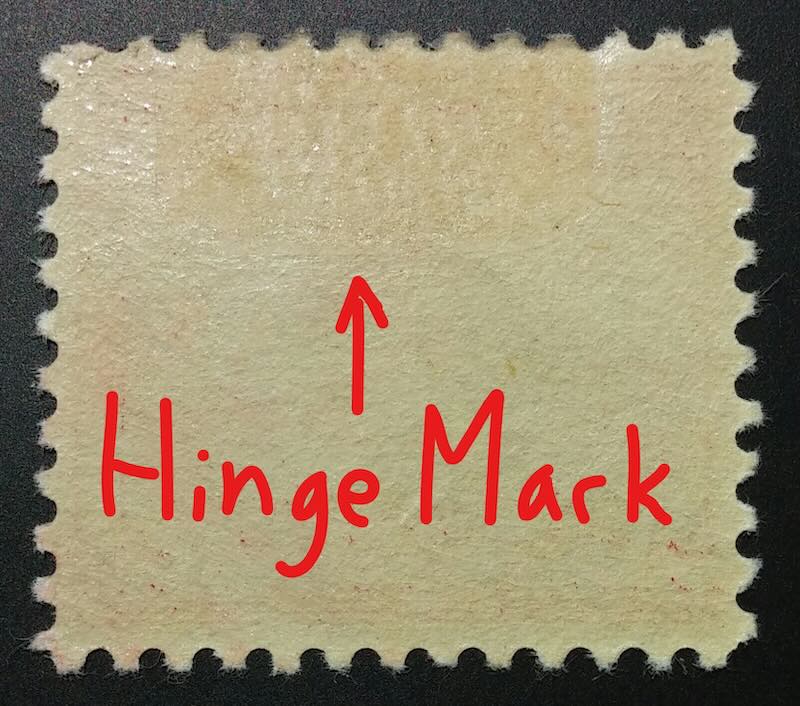
One of the most irritating things I discovered is that the ‘hinge’ is bad. For a clear answer I turned to Stamp Collecting Spot and their post on “Hinged vs Never Hinged Stamps“.
As a kid I spent an inordinate amount of time creating album pages, and laying out my stamps with hinges.
Now I learn that never hinged stamps are far more desirable than hinged stamps (of the same issue), because of their “fresher” state. Never hinged stamps are in the same shape as they were when originally bought at the Post Office.
However older stamps, especially those from the 19th century, are difficult to find in never hinged condition.
Detecting whether a stamp was once hinged isn’t an easy task. Sometimes hinge marks are so slight, you have to use a magnifying glass and hold it up to a light source in order tell whether there’s a hinge mark or not. The example stamp above actually has a very prominent hinge mark compared to some.
The only real difference is that never hinged stamps are closer to their original state than hinged stamps, which makes them more favoured by collectors.
Going through my old collection of stamps I found that some hinges just fell off, others just needed a little help, and most of the remaining hinges detached quite easily with a little tug.
Are all countries equal when talking about the quality of postage stamps?
As far as I understand things the technical evaluation of a postage stamp is a kind of reference, independent of country. But there is a feeling held by many collectors that some countries issue (or issued) mountains of cheap printed junk, imitating the approach of the old Communist puppet regimes just after WW II. Then there are countries that print sets about people or events that have nothing to do with the countries history, or even their present socio-economic situation. Some “collector sets” actually have the post marks (cancellations) included on them during the production. I’ve seen a series of stamps all with exactly the same cancellation mark in the same place.
Why would an African state put out sheets of stamps on Elvis or mushrooms? Why did some countries print stamps that look like wallpaper? Why should a South American country issue stamps with 19th illustrations of European or Asian plants and flowers?
What constitutes an 'old' postage stamp?
Are we on safer ground when looking at “old” stamps? The label “classic stamps“, typically applies to stamps printed in the early period of stamp production, e.g., before about 1870. The US Postal Museum appears to define 1847-1893 as the “classic period”, although I’ve read that 1840-1940 is considered the “classic period” worldwide. But also there could be a “classic period” for 1840-1900, a “middle period” or “neo-classic” period for 1900-1940, and a “modern period” after WW II (post-1945). Some experts pointed out that you could use Queen Victoria for the “classic period” and Queen Elizabeth II for the “modern period” (that would make Charles III the start of post-modernism).
Other experts define “vintage stamps” as older than some arbitrary year, such as 1960 or 1900, depending on the postal service history of each country. These vintage or classic stamps are solely defined by their age, so they include misprints, cancelled or un-cancelled, national or international, commemorative, and air-post selections.
Another threshold is when a postage stamp was demonetised, the process by which the stamps are rendered no longer valid. In the Eurozone, some countries demonetised stamps denominated in their old currency when moving to the euro. But others did not, and pre-euro stamps are still valid in Belgium, France, Italy and San Marino.
- The development or operation of one or more postal services and systems within a country, district or region or even between countries and continents
- Pre-adhesive postal services
- How postal rates evolved for different types of services
- Routes for transporting mail
- Military mail, field post, siege mail, POW, civil and military internee camp mail
- Maritime mail, railway mail and/or inland waterway mail
- Censorship mail
- Automation of mail
- Forwarding agent’s markings
- Official mail, free frank mail, etc.
Specialist interests
And we should not forget the way the postal system interacted with history, society, events, commerce, or the historical geography of an area, which must include:-
- The impact of the introduction of telegram services
- The role of greeting cards (including Valentines)
- Illustrated, pictorial, commercial envelopes used in the postal system
- The effect of a postal system on commerce, society and industry and the adaptation by commerce and industry of materials used in the postal system
- The role of post in highlighting an event or pointing to historical landmarks.
One interesting perspective, which I concur with, is that modern commemorative stamps are boring, even “special editions” and first day covers are mass produced as modern collectibles, and so almost by definition are not worth collecting.
While modern stamps by themselves may have become somewhat boring, postal history is more about “covers”, essentially an envelope or postcard that was sent through the mail. Cancels from unusual places or on specific dates can make a tremendous difference, firstly with collectors, and then with the prices they are willing to pay for good examples.
Another perspective is that the true stamp collector, as with all collectors, likes to hunt around for “finds”, and not be spoon-fed commemorative sets designed for their specific consumption. They are certainly interested in the theme, the look and feel, but also in the way the stamp was used, and how it represented something important in society, that is communication between individuals.
How to assess my stamps?
Stamps which are in unmounted mint condition are the most highly prized, and older stamps are obviously less likely to be available in ‘unmounted’ condition so there is a premium attached to them.
Grading stamps is something both collectors and dealers have done for years. Stamp grades directly affect a stamp’s value, scarcity and desirability. Grades are based on three factors: centring, condition, and eye appeal. Eye appeal simply adds a slight “bonus” or “discount” to the grade depending on whether a stamp has “excellent” or “poor” eye appeal.
I’ve “highjacked” the knowledge from Stamp Collecting Spot, who has a really good introduction to grading.
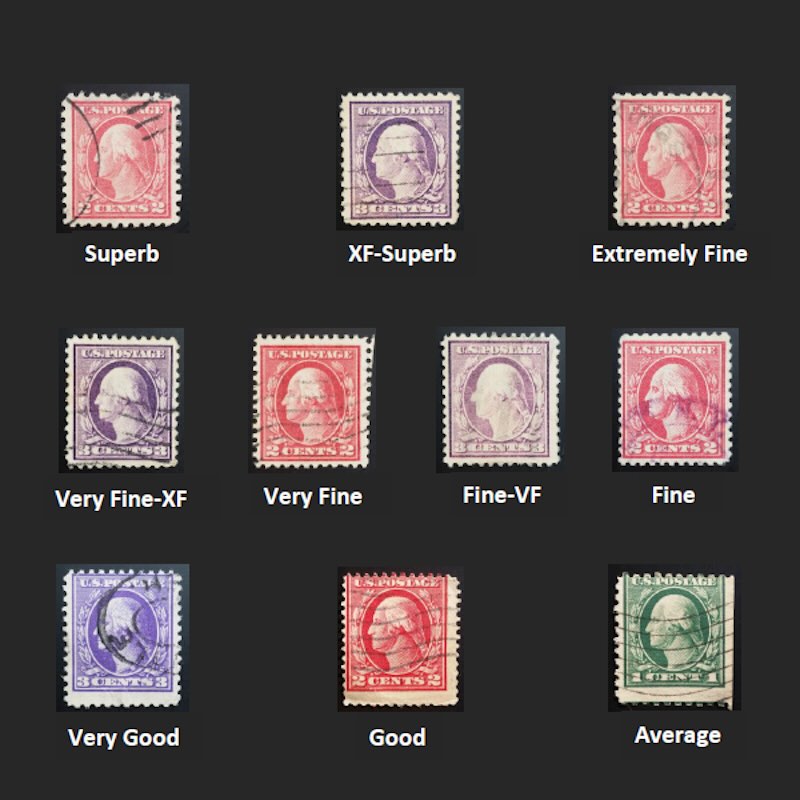
Early stamps are rarely found with perfect centring because of the printing methods which were used at that time. The image was printed first and perforation took place later. Many printers, especially in the early days, were not that fussy over perfect centring, producing what are called “perforation errors”. In many cases these were not errors, just poor workmanship, which detracts from the stamps value. If however the displacement is extreme, then the stamp may be considered a scarcer variety and be worth more as a result (I’ve seen them called “misperfs”). Only when the design starts to show clearly on the other side of the stamp, could it be considered an error which might add value. There’s a fine line between “poorly centred” which reduces the value, and “major misperf error” which could increase the value.
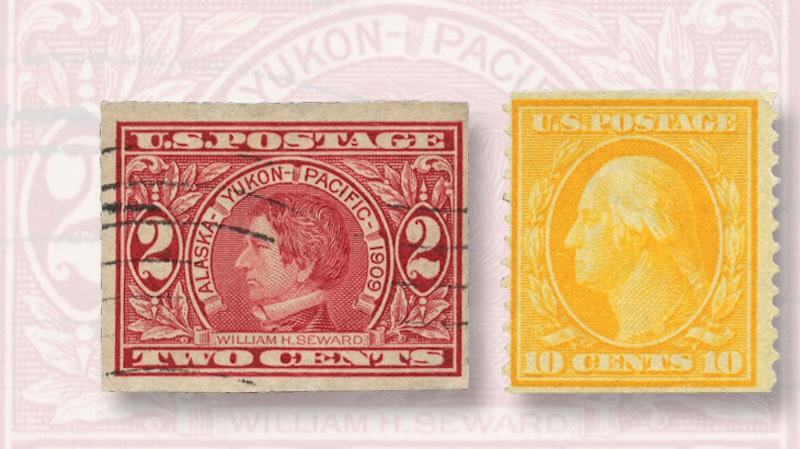
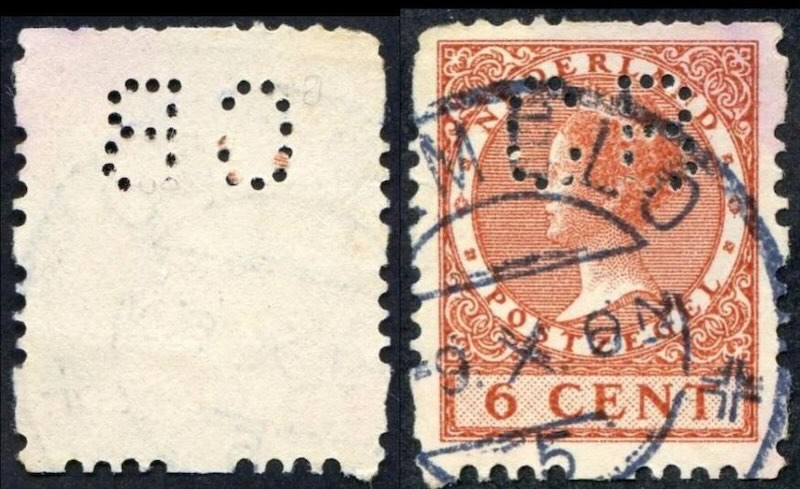
The term ‘pulled perf’ is used frequently in philatelic circles and means there is a gap where a perforation tooth has been pulled away. A ‘short perf’ or a ‘short corner’ means that a stamp has part of a perforation or corner perforation missing, and the stamp will be worth less.
As the gauge (number of perforations) increases, the impact of ‘short perfs’ on value also increases, ranging from a discount of between 20% and 50% of its full ‘mint’ value.
There is also a so-called “missing (perf) pin” where a perforation hole has been almost missed (leaving just a slight indent), and there are cases where there is no evidence of an indent, and this is called a “blind perf”. Clipped perfs are perforations that were cut short by scissors. Depending on the number of clipped perfs a stamp has, the grade could be reduced by one step or by multiple steps. It’s perfectly possible for people to clip a perforation to try to make it look like a missed pin, and make the stamp look more interesting to the specialist collector, and possible add value at the same time.
The first British stamps came with inscribed ‘sheet margins’ which offered advice for the public about their price and where to place them on a letter. Rare stamps with sheet margins which include a control number, plate number or printer’s imprint will greatly enhance an item’s value. For example, the highly sought-after Penny Black or Penny Red with a sheet margin might be worth between 50% and 100% more than a normal ‘mint’ example.
However, in most cases, a sheet margin does not have a significant impact on the value of the stamps to which they are attached.
Stamps which are damaged or have had their appearance altered are generally of lesser value.
What is soundness?
Depending on the severity and type of fault, a collectable stamp can still command a good price. However, the more obvious the damage is, the greater impact it will have on overall value.
As Stamp Collecting Spot points out there are many faults a stamp can have and if it has even one fault, it is instantly worth a fraction of what it would be worth if it were faultless. This is because most collectors don’t settle for low quality stamps when there are higher quality stamps easily available. Faults will also drastically lower a stamp’s overall grade. A serious fault will even render a stamp ungradable.
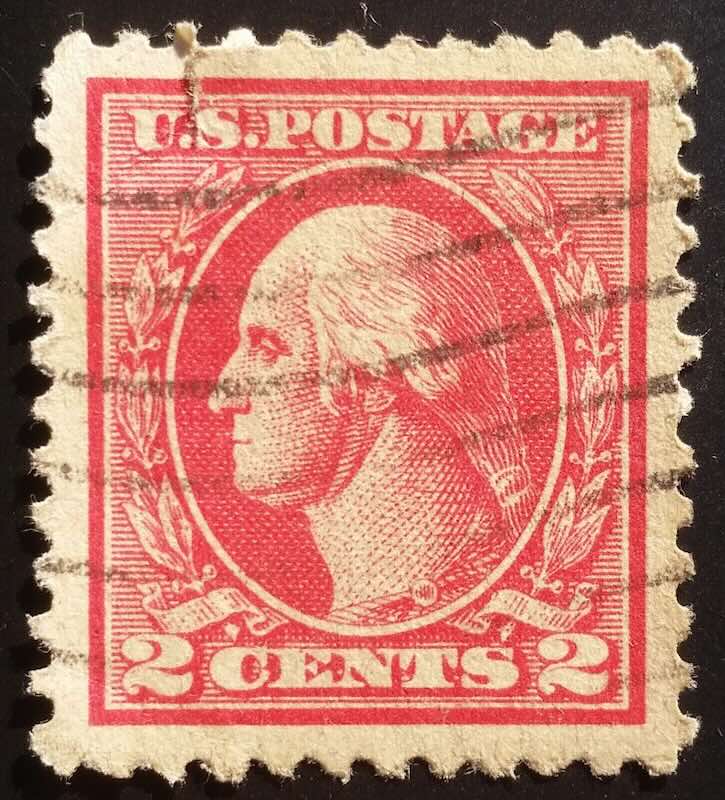
With the above example, despite having excellent centring, this stamp would receive a very low grade due to the tear in the upper left, and the crease in the upper right corner.
Tears are considered major faults, and depending on the size will reduce the grade by just a little, or even cause a stamp to be ungradable.
A surface scrape is where a portion of the stamp’s face is scraped off, leaving a blank area. Depending on the size, a surface scrape can reduce the grade by just one step, or by many steps.
Any bend can reduce a stamp’s value by 10% or 15%, even though it is usually only visible from the back.
If a crease is clearly visible on the front of a stamp then it’s a major fault. Expect it to be worth between 10% and 20% of its ‘mint’ value, depending on the severity of the crease and its location on the design. A series of light creases or ‘wrinkles’ will also devalue a stamp but less significantly.
Stamps which show signs of ‘rubbing’ or a ‘thin’ area are also worth less, depending on the severity of the damage. Average or large-sized thins can bring the grade down considerably, and even render a stamp ungradable. A hinge fault is obviously less serious than a central abrasion, so the impact on value must be judged accordingly.
Stamps with ‘perforated initials‘, a process which was carried out to discourage theft, are now proving very popular with collectors, unlike in the past when they were viewed negatively. Sometimes referred to as ‘perfins‘ they are often worth a similar amount compared to normal used issues.
It doesn’t matter whether a colour change (fading or discolouration) has been caused by water or sunlight, the impact on a stamp’s value is still significant. Realistically, even a highly-desirable rare stamp with discolouration is only worth up to 20% of its mint value whereas more common items are almost worthless if severely faded.
If a stamp has a ‘tone spot’ or brown marks which disfigure its design they are of reduced value. Often this results from poor storage and highlights the importance of looking after a collection. The more severe the toning and the more prominent the location, the less the stamp will be worth. Even a rare issue with a small spot in its centre will be devalued by around 25% to 50% compared to the same stamp in fine condition. Modern stamps with toning faults effectively have no value at all.
Although heavily cancelled stamps are usually worth considerably less, because they detract from the visual appearance, this is not true of all cancellations. In fact, there are cases where the cancellation is actually worth more than the stamp to which it has been applied.
Essentially, the aim for collectors who are keen on cancellations is to find stamps with unusual and scare postmarks. For example, a Wotton-under-Edge Maltese cross is worth more as a ‘fine’ or ‘full cancellation’ (where the mark has been strongly made but the design remains clear) as opposed to one which has been applied lightly.
Postmark collectors are generally interested in where and when a stamp was cancelled. However, any cancellation marks should be lightly applied, displayed in full and well centred to fall into the top category.
And finally, the following faults make a stamp ungradable. Stamps with these faults are considered “spacefillers”.
One or more edges of a stamp are straight, without perforations. Straight edges are the result of a stamp having been cut from the edge or corner of a sheet. Straight edges are considered major faults, and a stamp with a straight edge or two is ungradable.
An alteration made to a stamp by adding fake perforations with the intention of improving the stamp’s eye appeal and value. A re-perforated stamp cannot be graded.
Considered as major faults, stamps with pinholes are ungradable.
Of course, if a stamp has missing pieces it is considered ungradable. Many also consider these stamps “trash”.
In the eye of the beholder
Stamps with excellent eye appeal enjoy an increased grade, and those with poor eye appeal suffer a discount to their grade.
Fancy cancels, very light cancels, uncommonly vivid color, and a crisp, “Post Office fresh” feel are among the qualities that increase a stamp’s eye appeal, and therefore grade. In general, these qualities increase the grade by one step.
Limpness, heavy cancels, and pen cancels all decrease the eye appeal and grade. Poor “qualities” like these usually decrease the grade by one step, but if they’re severe enough, can decrease the grade by several steps.
The author of “How to Grade Stamps Yourself” also listed some of the articles that helped him learn to grade stamps:-
In my posts I will need to translate the above into a real world situation, with my real world stamps sitting in my real world shoeboxes.









